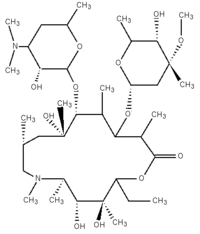Azithromycin
Azithromycin is the first macrolide antibiotic belonging to the azalide group. Azithromycin is derived from erythromycin by adding a nitrogen atom into the lactone ring of erythromycin A, thus making the lactone ring 15-membered. Azithromycin is sold under the brand names Zithromax ("Zmax") and Sumamed, and is one of the world's best-selling antibiotics. Azithromycin is used for the treatment of respiratory-tract, soft-tissue and genitourinary infections. more...
Etymology
Azithromycin's name is derived from the azane-substituent and erythromycin. Its accurate chemical name is
(2R,3S,4R,5R,8R,10R,11R,12S,13S,14R)-13- -2-ethyl- 3,4,10-trihydroxy-3,5,6,8,10,12,14-heptamethyl -11--1-oxa- 6-azacyclopentadecan-15-one.
History
A team of Pliva's researchers, Gabrijela Kobrehel, Gorjana Radobolja-Lazarevski and Zrinka Tamburasev led by Dr Slobodan Dokic, discovered azithromycin in 1980. It was patented in 1981, and was later found by Pfizer's scientists while going through patent documents. In 1986 Pliva and Pfizer signed a licensing agreement which gave Pfizer exclusive rights for the sale of azithromycin in Western Europe and the United States. Pliva brought their azithromycin on the market in Central and Eastern Europe under the brand name of Sumamed in 1988, and Pfizer Zithromax in 1991.
Available forms
Azithromycin is commonly administered in tablet or oral suspension (a one-dose version was made available in 2005). It is also available for intravenous injection.
Mechanism of action
Azithromycin prevents bacteria from growing by interfering with their protein synthesis. Azithromycin binds to the 50S subunit of the bacterial ribosome, and thus inhibits translation of mRNA. Azithromycin has similar antimicrobial spectrum as erythromycin, but is more effective against certain gram-negative bacteria, particularly Haemophilus influenzae.
Pharmacokinetics
Unlike erythromycin, azithromycin is acid-stable and can therefore be taken orally without being protected from gastric acids. It is readily absorbed, and diffused into most tissues and phagocytes. Due to the high concentration in phagocytes, azithromycin is actively transported to the site of infection. During active phagocytosis, large concentrations of azithromycin are released. The concentration of azithromycin in the tissues can be over 50 times higher than in plasma. This is due to ion trapping and the high lipid solubility.
Metabolism
Azithromycin's half-life is approximately 2 days, and it's fairly resistant to metabolic inactivation. Its main elimination route is through excretion in the biliary fluid, and some can also be eliminated through urinary excretion. Azithromycin is excreted through both of these elimination routes mainly in unchanged form.
Side effects
Most common side effects are gastrointestinal; diarrhea, nausea, abdominal pain and vomiting.
Reference links
- MedicineNet.com - Azithromycin
Read more at Wikipedia.org



